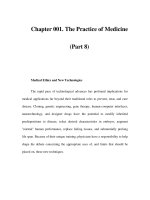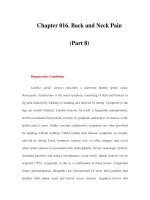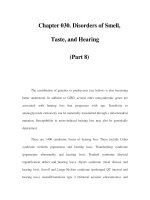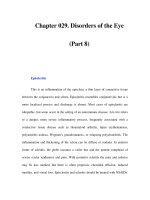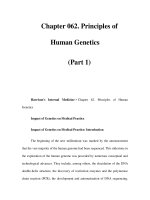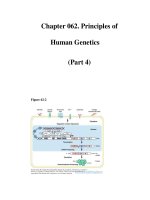BASIC HUMAN ANATOMY - PART 8 pps
Bạn đang xem bản rút gọn của tài liệu. Xem và tải ngay bản đầy đủ của tài liệu tại đây (220.36 KB, 24 trang )
MD0006 10-3
b. The Endocrine System. In the human body, the endocrine system consists
of a number of ductless glands producing their specific hormones. Because these
hormones are carried to their target organs by the bloodstream, the endocrine organs
(glands) are richly supplied with blood vessels.
c. Better Known Endocrine Organs of Humans. The better known endocrine
organs are the:
(1) Pituitary body.
(2) Thyroid gland.
(3) Parathyroid glands.
(4) Pancreatic islets (islands of Langerhans).
(5) Suprarenal (adrenal) glands.
(6) Gonads (female ovaries; male testes).
In addition, there are several other endocrine organs, less well understood, and other
organs suspected to be of the endocrine type. See figure 10-1, which shows the better
known endocrine glands and their locations.
Figure 10-1. The endocrine glands of the human body and their locations.
MD0006 10-4
Section II. THE PITUITARY BODY
10-3. GENERAL
a. Location. The pituitary body is a small pea-sized and pea- shaped
structure. It is attached to the base of the brain in the region of the hypothalamus (see
paragraph 11-9). In addition, it is housed within a hollow of the bony floor of the cranial
cavity. This hollow is called the sella turcica ("Turk's saddle").
b. Major Subdivisions. The pituitary body is actually two glands the poste-
rior pituitary gland and the anterior pituitary gland. Initially separate, these glands join
together during development of the embryo.
10-4. POSTERIOR PITUITARY GLAND
The posterior pituitary gland is the portion which comes from and retains a direct
connection with the base of the brain. The hormones of the posterior pituitary gland are
actually produced in the hypothalamus of the brain. From the hypothalamus, the
hormones are delivered to the posterior pituitary gland, where they are released into the
bloodstream. At present, we recognize two hormones of the posterior pituitary gland.
a. ADH (Antidiuretic Hormone). ADH is involved with the resorption or
salvaging of water within the kidneys. ADH is produced under thirst conditions.
b. Oxytocin. Oxytocin is concerned with contractions of smooth muscle in
the uterus and with milk secretion.
10-5. ANTERIOR PITUITARY GLAND
a. The anterior pituitary gland originates from the roof of the embryo's mouth. It
then "attaches" itself to the posterior pituitary gland.
b. The anterior pituitary gland is indirectly connected to the hypothalamus by
means of a venous portal system. By "portal," we mean that the veins carry substances
from the capillaries at one point to the capillaries at another point (hypothalamus to the
anterior pituitary gland).
c. In the hypothalamus, certain chemicals known as releasing factors are
produced. These are carried by the portal system to the anterior pituitary gland. Here,
they stimulate the cells of the anterior pituitary gland to secrete their specific hormones.
d. The anterior pituitary gland produces many hormones. In general, they
stimulate the target organs to develop or produce their own products. This stimulating
effect is referred to as trophic.
MD0006 10-5
e. Of the many hormones produced by the anterior pituitary gland, we will
examine:
(1) Somatotrophic hormone (growth hormone). The target organs of this
hormone are the growing structures of the body. This hormone influences such
structures to grow.
(2) ACTH (adrenocorticotrophic hormone). This hormone of the anterior
pituitary gland stimulates the cortex of the suprarenal (adrenal) gland to produce its
hormones. We will later see that the hormones of the suprarenal cortex are involved
with anti-inflammatory reactions of the body.
(3) Thyrotropin (TSH). This hormone stimulates the thyroid gland
to produce its hormones.
(4) Luteinizing hormone (LH). LH stimulates ovulation and luteinization of
ovarian follicles in females and promotes testosterone production in males.
(5) Follicle-stimulating hormone (FSH). FSH stimulates ovarian follicle
growth in females and stimulates spermatogenesis in males.
(6) Prolactin. Prolactin stimulates milk production and maternal behavior in
females.
Section III. THE THYROID GLAND
10-6. LOCATION
The thyroid gland is in the neck region just below the larynx and surrounds the
trachea.
10-7. ANATOMY
a. The right and left thyroid lobes are the masses on either side of the trachea.
The isthmus is found across the front of the trachea and connects the two lobes.
b. Each lobe of the thyroid gland is supplied by arteries from above and below
(superior and inferior thyroid arteries).
10-8. HORMONES
The primary hormone of the thyroid gland is thyroxin. Thyroxin affects the basal
metabolic rate (BMR), the level of activity of the body. Since iodine is a necessary ele-
ment in the production of thyroxin, one can observe malformations of the thyroid gland
MD0006 10-6
(called goiters) where there is little or no iodine available. A second hormone, calcito-
nin, is produced by the thyroid gland and it is involved with calcium metabolism in the
body.
Section IV. THE PARATHYROID GLANDS
10-9. LOCATION AND STRUCTURE
Located on the posterior aspects of the thyroid lobes are two pairs of small
round masses of tissue, known as the parathyroid glands.
10-10. HORMONE
The hormone produced by these glands is called parathyroid hormone, or
parathormone. It is involved with calcium metabolism.
Section V. THE PANCREATIC ISLETS (ISLANDS OF LANGERHANS)
10-11. LOCATION AND STRUCTURE
Within the substance of the pancreas are distributed small groups of cells known
as islets. Although the pancreas is a ducted gland of the digestive system, these
isolated islets are, in fact, ductless glands.
10-12. HORMONES
Insulin and glucagon are the two most commonly recognized hormones of the
islets. These hormones are involved with glucose metabolism.
Section VI. THE SUPRARENAL (ADRENAL) GLANDS
10-13. LOCATION AND STRUCTURE
Embedded in the fat above each kidney is a suprarenal gland. Both suprarenal
glands have an internal medulla and an external cortex.
10-14. HORMONES OF THE SUPRARENAL MEDULLA
The medullary portion of each suprarenal gland produces a pair of
hormones epinephrine (adrenalin) and norepinephrine (noradrenalin). These
MD0006 10-7
hormones are involved in the mobilization of energy during the stress reaction ("fight or
flight").
10-15. HORMONES OF THE SUPRARENAL CORTEX
Each suprarenal cortex produces a variety of hormones which can be grouped
into three categories:
a. Mineralocorticoids (for example, aldosterone), which are concerned with
the electrolytes of the body.
b. Glucocorticoids (for example, cortisol), which are concerned with many
metabolic functions and are anti-inflammatory in nature.
c. Sex hormones. Adrenal androgens and estrogens.
Section VII. THE GONADS
10-16. GENERAL
In humans, the primary sex organs are known as gonads (lesson 8). The
gonads produce sex cells (gametes) and sex hormones. These sex hormones are in
addition to those produced by the suprarenal cortex (see para 10-15c).
10-17. FEMALE SEX HORMONES
In the female, the ovaries produce two types of sex hormones during the men-
strual cycle. During the first half of the cycle (days 1 - 14), the estrogens are produced.
During the last half of the cycle (days 15 - 28), progesterone is produced. These hor-
mones are concerned with female sexuality and with the preparation of female sex
organs for reproduction.
10-18. MALE SEX HORMONES
In the male, certain cells of the testes produce the male sex hormones known as
androgens (for example, testosterone). Androgens are concerned with male sexuality.
Continue with Exercises
MD0006 10-9
5. The pituitary body is a small -sized and -shaped structure. It is
attached to the base of the brain in the region of the h . In addition, it is
housed within a hollow of the bony floor of the cavity. The pituitary body is
actually two glands: the pituitary gland and the pituitary gland.
6. The posterior pituitary gland is that portion of the pituitary body which comes
from and retains its connection with the . The hormones of
the posterior pituitary gland are actually produced in the h of the brain. The
two recognized hormones of the posterior pituitary gland are (a
hormone) and . The first is involved with the of water within
the kidneys; it is produced under conditions. The second is concerned with
contractions of smooth muscle in the and with production.
7. The anterior pituitary gland originates from the roof of the embryo's
. It then attaches itself to the gland. By means of
a venous portal system, the anterior pituitary gland is connected to the h .
Here, certain chemicals known as r f are produced. These are
carried to the anterior pituitary by the system. They stimulate the
anterior pituitary gland's cells to secrete their specific . In turn, these
hormones stimulate the target organs to produce their own products. This stimulating
effect is referred to as . Two hormones produced by the anterior
pituitary gland are trophic hormone and ( trophic hormone).
The target organs of the first are the ing structures of the body. The
second stimulates the cortex of the ( ) gland to produce its hormones.
8. The thyroid gland is in the region just below the and
surrounds the . The masses on either side of the trachea are the right and left
thyroid . The tissue connecting the two lobes is called the . It is found
across the front of the . Each lobe of the thyroid gland is supplied by
the superior and inferior arteries. The primary hormone of the thyroid gland
is , which affects the ( ), the level of
activity of the body.
9. Where are the parathyroid glands located?
The hormone produced by these glands is called hormone or
. It is involved with metabolism.
MD0006 10-10
10. Within the pancreas are distributed small groups of cells known as .
The two most commonly recognized hormones of the islets are and
. These hormones are involved with metabolism.
11. The suprarenal glands are embedded in the fat above the ____________
on each side. Each suprarenal gland has an internal and an external
. The inner portion produces a pair of hormones:
e ( ) and n ( ). These
are involved in the mobilization of during the stress reaction (" or
"). Each suprarenal cortex produces hormones which can be grouped into
three different categories:
a. M s (for example, aldosterone), which are
concerned with the of the body.
b. G s (for example, cortisol), which are concerned with
many metabolic functions and are anti- in nature.
c. hormones.
12. In humans, the primary sex organs are known as s. These organs
produce cells ( ) and sex s.
13. During the first half of the menstrual cycle, the ovaries produce s.
During the second half, they produce e. These hormones are concerned
with female y and with the preparation of female sex s
for reproduction.
14. The testes produce the male sex hormones known as (for
example, ). These hormones are concerned with male .
Check Your Answers on Next Page
MD0006 10-11
SOLUTIONS TO EXERCISES, LESSON 10
1. Endocrine glands are glands of internal secretion. These glands are also called
ductless glands. Hormones are the secretions produced by endocrine glands.
Target organs are the specific organs or tissues to which hormones are carried by
the bloodstream. This is a feedback mechanism because the activity of the target
organ affects the activity of the endocrine organ. (para 10-1)
2. The fundamental control "system" is the interaction of heredity and environment.
Genes determine the range of potentiality. Environment develops it. Controlling
the tissues and organs in general are the hormones of the endocrine system.
Providing more precise and immediate control of the body structures is the
nervous system. (para 10-2a)
3. Endocrine organs are richly supplied with blood vessels because hormones must
be carried to their target organs by the bloodstream. (para 10-2b)
4. a. Pituitary body.
b. Thyroid gland.
c. Parathyroid glands.
d. Pancreatic islets.
e. Suprarenal (adrenal) glands.
f. Gonads (female ovaries, male testes). (para 10-2c)
5. The pituitary body is a small pea-sized and pea-shaped structure. It is attached to
the base of the brain in the region of the hypothalamus. In addition, it is housed
within a hollow of the bony floor of the cranial cavity. The pituitary body is actually
two glands: the posterior pituitary gland and the anterior pituitary gland.
(para 10-3)
6. The posterior pituitary gland is that portion of the pituitary body which comes from
and retains its connection with the base of the brain. The hormones of the
posterior pituitary gland are actually produced in the hypothalamus of the brain.
The two recognized hormones of the posterior pituitary gland are ADH (antidiuretic
hormone) and oxytocin. The first is involved with the resorption or salvaging of
water within the kidneys; it is produced under thirst conditions. The second is
concerned with contraction of smooth muscle in the uterus and with milk
production. (para 10-4)
MD0006 10-12
7. The anterior pituitary gland originates from the roof of the embryo's mouth. It then
attaches itself to the posterior pituitary gland. By means of a venous portal
system, the anterior pituitary gland is connected to the hypothalamus. Here,
certain chemicals known as releasing factors are produced. These are carried to
the anterior pituitary by the venous portal system. They stimulate the anterior
pituitary gland's cells to secrete their specific hormones. In turn, these hormones
stimulate the target organs to produce their own products. This stimulating effect
is referred to as trophic. Two of the hormones produced by the anterior pituitary
gland are somatotrophic hormone and ACTH (adrenocorticotrophic hormone).
The target organs of the first are the growing structures of the body. The second
stimulates the cortex of the suprarenal (adrenal) gland to produce its own
hormones. (para 10-5)
8. The thyroid gland is in the neck region just below the larynx and surrounds the
trachea. The masses on either side of the trachea are the right and left thyroid
lobes. The tissue connecting the two lobes is called the isthmus. It is found
across the front of the trachea. Each lobe of the thyroid gland is supplied by the
superior and inferior thyroid arteries. The primary hormone of the thyroid gland is
thyroxin, which affects the basal metabolic rate (BMR), the level of activity of the
body. (paras 10-6 10-8)
9. The parathyroid glands are located on the posterior aspects of the thyroid lobes.
The hormone produced by these glands is called parathyroid hormone or
parathormone. It is involved with calcium metabolism. (paras 10-9, 10-10)
10. Within the pancreas are distributed small groups of cells known as islets. The two
most commonly recognized hormones of the islets are insulin and glucagon.
Theses hormones are involved with glucose metabolism. (paras 10-11, 10-12)
11. The suprarenal glands are embedded in the fat above the kidney on each side.
Each suprarenal gland has an internal medulla and an external cortex. The inner
portion produces a pair of hormones: epinephrine (adrenalin) and norepinephrine
(noradrenalin). These are involved in the mobilization of energy during the stress
reaction ("fight or flight"). Each suprarenal cortex produces hormones which can
be grouped into three different categories:
a. Mineralocorticoids (for example, aldosterone), which are concerned with the
electrolytes of the body.
b. Glucocorticoids (for example, cortisol), which are concerned with many
metabolic functions and are anti-inflammatory in nature.
c. Sex hormones. (paras 10-13 10-15)
12. In humans, the primary sex organs are known as gonads. These organs produce
sex cells (gametes) and sex hormones. (para 10-16)
MD0006 10-13
13. During the first half of the menstrual cycle, the ovaries produce estrogens. During
the second half, they produce progesterone. These hormones are concerned with
female sexuality and with the preparation of female sex organs for reproduction.
(para 10-17)
14. The testes produce the male sex hormones known as androgens (for example,
testosterone). These hormones are concerned with male sexuality. (para 10-18)
End of Lesson 10
MD0006 11-1
LESSON ASSIGNMENT
LESSON 11 The Human Nervous System.
TEXT ASSIGNMENT Paragraphs 11-1 through 11-39.
LESSON OBJECTIVES After completing this lesson, you should be able to:
11-1. Name and identify two types of nervous
tissues.
11-2. Name three functions for which nervous
tissues are specialized.
11-3. Define neuron, dendrite, and axon.
11-4. When given the shape, diameter, or function,
name the corresponding type of neuron.
11-5. Describe neuron "connections," including the
synapse and the neuromuscular junction.
11-6. Name and identify the three major divisions of
the human nervous system; name the two
major subdivisions of the CNS.
11-7. Name and briefly describe the three major
subdivisions of the human brain; name and
locate the four ventricles and their connecting
channels.
11-8. Describe the spinal cord, including the two
enlargements, elements of its cross section,
and the surrounding vertebral canal.
11-9. Describe the meninges and the skeletal
coverings of the CNS.
11-10. Name and identify the main arteries and veins
of the brain and briefly describe the blood
supply of the spinal cord.
11-11. Describe the formation of cerebrospinal fluid
(CSF) and the path of CSF flow.
MD0006 11-2
11-12. Define peripheral nervous system (PNS) and
nerve; name and briefly describe two
categories of PNS nerves; describe the
anatomy of a "typical" spinal nerve; define
reflex and reflex arc; briefly describe the
components of the general reflex arc.
11-13. Define autonomic nervous system (ANS) and
visceral organs; briefly describe efferent
pathways of the ANS; name the major
divisions of the human ANS; briefly describe
the major activities of the human ANS for the
thoraco-lumbar and cranio-sacral outflows;
briefly describe the first and second neurons,
innervations, and effects in each case.
11-14. Define pathway, neuraxis, sensor pathway,
and motor pathway; briefly describe levels of
control, pyramidal and extra-pyramidal motor
pathways, and sensory pathways; and give
examples of general senses and special
senses.
11-15. Briefly describe the sensory receptors and
sensory pathways for the special senses of
smell and taste.
11-16. Describe the structures of the bulbus oculi,
the orbit, and the adnexa.
11-17. Describe the structures of the external ear,
the middle ear, and the internal ear.
11-18. Describe the structures of the sacculus,
utriculus, semicircular ducts, and the
vestibular nerve.
11-19. Describe controls in the human nervous
system.
SUGGESTION After completing the assignment, complete the
exercises at the end of this lesson. These exercises
will help you to achieve the lesson objectives.
MD0006 11-3
LESSON 11
THE HUMAN NERVOUS SYSTEM
Section I. INTRODUCTION
11-1. NERVOUS TISSUES
There are two types of nervous tissues the neurons (nerve cells) and glia
(neuroglia). See paragraph 2-17. The neuron is the basic structural unit of the nervous
system. The glia are cells of supporting tissue for the nervous system. There are
several different types of glia, but their general function is support (physical, nutritive,
etc.).
11-2. SPECIALIZATION
Nervous tissues are specialized to:
a. Receive Stimuli. Cells receiving stimuli are said to be "irritable" (as are all
living cells to a degree).
b. Transmit Information.
c. "Store" Information. The storing of information is called memory.
Section II. THE NEURON AND ITS "CONNECTIONS"
11-3. DEFINITION
A neuron (figure 11-1) is a nerve cell body and all of its processes (branches).
11-4. NEURON CELL BODY
The neuron cell body is similar to that of the "typical" animal cell described in
lesson 1.
MD0006 11-4
Figure 11-1. A "typical" neuron.
11-5. NEURON PROCESSES
There are two types of neuron processes dendrites and axons.
a. Dendrite. A dendrite is a neuron process which carries impulses toward the
cell body. Each neuron may have one or more dendrites. Dendrites receive information
and transmit (carry) it to the cell body.
b. Axon. An axon is a neuron process which transmits information from the cell
body to the next unit. Each neuron has only one axon.
c. Information Transmission. Information is carried as electrical impulses
along the length of the neuron.
d. Coverings. Some neuron processes have a covering which is a series of
Schwann cells, interrupted by nodes (thin spots). This gives the neuron process the
appearance of links of sausage. The Schwann cells produce a lipid (fatty) material
called myelin. This myelin acts as an electrical insulator during the transmission of
impulses.
MD0006 11-5
11-6. TYPES OF NEURONS
Neurons may be identified according to shape, diameter of their processes, or
function.
a. According to Shape. A pole is the point where a neuron process meets the
cell body. To determine the type according to shape, count the number of poles.
(1) Multipolar neurons. Multipolar neurons have more than two poles (one
axon and two or more dendrites).
(2) Bipolar neurons. Bipolar neurons have two poles (one axon and one
dendrite).
(3) Unipolar neurons. Unipolar neurons have a single process which
branches into a T-shape. One arm is an axon; the other is a dendrite.
b. According to Diameter (Thickness) of Processes. Neurons may be rated
according to the thickness of myelin surrounding the axon. In order of decreasing
thickness, they are rated A (thickest), B, and C (thinnest). The thickness affects the rate
at which impulses are transmitted. The thickest are fastest. The thinnest are slowest.
c. According to Function.
(1) Sensory neurons. In sensory neurons, impulses are transmitted from
receptor organs (for pain, vision, hearing, etc.) to the central nervous system (CNS).
(2) Motor neurons. In motor neurons, impulses are transmitted from the
CNS to muscles and glands (effector organs).
(3) Interneurons. Interneurons transmit information from one neuron to
another. An interneuron "connects" two other neurons.
(4) Others. There are other, more specialized types, for example, in the
CNS.
11-7. NEURON "CONNECTIONS"
A neuron may "connect" either with another neuron or with a muscle fiber. A
phrase used to describe such "connections" is "continuity without contact." Neurons do
not actually touch. There is just enough space to prevent the electrical transmission
from crossing from the first neuron to the next. This space is called the synaptic cleft.
Information is transferred across the synaptic cleft by chemicals called neurotransmit-
ters. Neurotransmitters are manufactured and stored on only one side of the cleft.
Because of this, information flows in only one direction across the cleft.
MD0006 11-6
a. The Synapse. A synapse (figure 11-2) is a "connection" between two
neurons.
Figure 11-2. A synapse.
(1) First neuron. An axon terminates in tiny branches. At the end of each
branch is found a terminal bulb. Synaptic vesicles (bundles of neurotransmitter) are
located within each terminal bulb. That portion of the terminal bulb which faces the
synaptic cleft is thickened and is called the presynaptic membrane. This is the mem-
brane through which neurotransmitters pass to enter the synaptic cleft.
(2) Synaptic cleft. The synaptic cleft is the space between the terminal bulb
of the first neuron and the dendrite or cell body of the second neuron.
(3) Second neuron. The terminal bulb of the first neuron lies near a site on
a dendrite or the cell body of the second neuron. The membrane at this site on the
second neuron is known as the postsynaptic membrane. Within the second neuron is a
chemical that inactivates the used neurotransmitter.
b. The Neuromuscular Junction. A neuromuscular junction (figure 11-3) is a
"connection" between the terminal of a motor neuron and a muscle fiber. The
neuromuscular junction has an organization identical to a synapse. However, the bulb
is larger. The postsynaptic membrane is also larger and has foldings to increase its
surface area.
MD0006 11-7
Figure 11-3. A neuromuscular junction.
(1) Motor neuron. The axon of a motor neuron ends as it reaches a striated
muscle fiber (of a skeletal muscle). At this point, it has a terminal bulb. Within this bulb
are synaptic vesicles (bundles of neurotransmitter). The presynaptic membrane lines
the surface of the terminal bulb and lies close to the muscle fiber.
(2) Synaptic cleft. The synaptic cleft is a space between the terminal bulb of
the motor neuron and the membrane of the muscle fiber.
(3) Muscle fiber. The terminal bulb of the motor neuron protrudes into the
surface of the muscle fiber. The membrane lining the synaptic space has foldings and
is called the postsynaptic membrane. Beneath the postsynaptic membrane is a chemi-
cal which inactivates the used neurotransmitter.
Section III. THE HUMAN CENTRAL NERVOUS SYSTEM
11-8. GENERAL
The major divisions of the human nervous system are the central nervous
system (CNS), the peripheral nervous system (PNS), and the autonomic nervous
MD0006 11-8
system (ANS). The CNS is made up of the brain and spinal cord. Both the PNS and
the ANS carry information to and from the central nervous system. The PNS is
generally concerned with the innervation of skeletal muscles and other muscles made
up of striated muscle tissue, as well as sensory information from the periphery of the
body. The ANS is that portion of the nervous system concerned with control of smooth
muscle, cardiac muscle, and glands. The CNS (figure 11-4) is known as central
because its anatomical location is along the central axis of the body and because the
CNS is central in function. If we use a computer analogy to understand that it is central
in function, the CNS would be the central processing unit and other parts of the nervous
system would supply inputs and transmit outputs.
Figure 11-4. The human central nervous system.
MD0006 11-10
Figure 11-5B. Human brain (bottom view).
a. The Brainstem. The term brainstem refers to that part of the brain that
would remain after removal of the cerebrum and cerebellum. The brainstem is the
basal portion (portion of the base) of the brain. The brainstem can be divided as
follows:
FOREBRAINSTEM: thalamus
hypothalamus
MIDBRAINSTEM: corpora quadrigemina
cerebral peduncles
HINDBRAINSTEM: pons
medulla
(1) The brainstem is continuous with the spinal cord. Together, the brain-
stem and the spinal cord are sometimes known as the neuraxis.
(2) The brainstem provides major relays and controls for information
passing up or down the neuraxis.
MD0006 11-11
(3) The 12 pairs of cranial nerves connect at the sides of the brainstem.
b. Cerebellum. The cerebellum is a spherical mass of nervous tissue attached
to and covering the hindbrainstem. It has a narrow central part called the vermis and
right and left cerebellar hemispheres.
(1) Peduncles. A peduncle is a stem-like connecting part. The cerebellum
is connected to the brainstem with three pairs of peduncles.
(2) General shape and construction. A cross section of the cerebellum
reveals that the outer cortex is composed of gray matter (cell bodies of neurons) with
many folds and sulci (shallow grooves). More centrally located is the white matter
(myelinated processes of neurons).
(3) Function. The cerebellum is the primary coordinator/integrator of motor
actions of the body.
c. Cerebrum. The cerebrum consists of two very much enlarged hemispheres
connected to each other by a special structure called the corpus callosum. Each
cerebral hemisphere is connected to the brainstem by a cerebral peduncle. The surface
of each cerebral hemisphere is subdivided into areas known as lobes. Each lobe is
named according to the cranial bone under which it lies: frontal, parietal, occipital, and
temporal.
(1) The space separating the two cerebral hemispheres is called the
longitudinal fissure. The shallow grooves in the surface of the cerebrum are called sulci
(sulcus, singular). The ridges outlined by the sulci are known as gyri (gyrus, singular).
(2) The cerebral cortex is the gray outer layer of each hemisphere. The
occurrence of sulci and gyri helps to increase the amount of this layer. Deeper within
the cerebral hemispheres, the tissue is white. The "gray matter" represents cell bodies
of the neurons. The "white matter" represents the axons.
(3) The areas of the cortex are associated with groups of related functions.
(a) For example, centers of speech and hearing are located along the
lateral sulcus, at the side of each hemisphere.
(b) Vision is centered at the rear in the area known as the occipital lobe.
(c) Sensory and motor functions are located along the central sulcus,
which separates the frontal and parietal lobes of each hemisphere. The motor areas
are located along the front side of the central sulcus, in the frontal lobe. The sensory
areas are located along the rear side of the central sulcus, in the parietal lobe.
MD0006 11-12
d. Ventricles. Within the brain, there are interconnected hollow spaces filled
with cerebrospinal fluid (CSF). These hollow spaces are known as ventricles. The right
and left lateral ventricles are found in the cerebral hemispheres. The lateral ventricles
are connected to the third ventricle via the interventricular foramen (of Monroe). The
third ventricle is located in the forebrainstem. The fourth ventricle is in the
hindbrainstem. The cerebral aqueduct (of Sylvius) is a short tube through the
midbrainstem which connects the third and fourth ventricles. The fourth ventricle is
continuous with the narrow central canal of the spinal cord.
11-10. THE HUMAN SPINAL CORD
a. Location and Extent. Referring to figure 4-4, you can see that the typical
vertebra has a large opening called the vertebral (or spinal) foramen. Together, these
foramina form the vertebral (spinal) canal for the entire vertebral column. The spinal
cord, located within the spinal canal, is continuous with the brainstem. The spinal cord
travels the length from the foramen magnum at the base of the skull to the junction of
the first and second lumbar vertebrae.
(1) Enlargements. The spinal cord has two enlargements. One is the
cervical enlargement, associated with nerves for the upper members. The other is the
lumbosacral enlargement, associated with nerves for the lower members.
(2) Spinal nerves. A nerve is a bundle of neuron processes which carry
impulses to and from the CNS. Those nerves arising from the spinal cord are spinal
nerves. There are 31 pairs of spinal nerves.
b. A Cross Section of the Spinal Cord (figure 11-6). The spinal cord is a
continuous structure which runs through the vertebral canal down to the lumbar region
of the column. It is composed of a mass of central gray matter (cell bodies of neurons)
surrounded by peripheral white matter (myelinated processes of neurons). The gray
and white matter are thus considered columns of material. However, in a cross section,
this effect of columns is lost.
(1) Central canal. A very narrow canal, called the central canal, is located in
the center of the spinal cord. The central canal is continuous with the fourth ventricle of
the brain.
(2) The gray matter. In the cross section of the spinal cord, one can see a
central H-shaped region of gray matter. Each arm of the H is called a horn, resulting in
two posterior horns and two anterior horns. The connecting link is called the gray
commissure. Since the gray matter extends the full length of the spinal cord, these
horns are actually sections of the gray columns.
(3) The white matter. The peripheral portion of the spinal cord cross section
consists of white matter. Since a column of white matter is a large bundle of processes,
it is called a funiculus. In figure 11-6, note the anterior, lateral, and posterior funiculi.
MD0006 11-13
Figure 11-6. A cross-section of the spinal cord.
11-11. COVERINGS OF THE CNS
The coverings of the CNS are skeletal and fibrous.
a. Skeletal Coverings.
(1) Brain. The bones of the cranium form a spherical case around the brain.
The cranial cavity is the space inclosed by the bones of the cranium.
(2) Spinal cord. The vertebrae, with the vertebral foramina, form a
cylindrical case around the spinal cord. The overall skeletal structure is the vertebral
column (spine). The vertebral (spinal) canal is the space inclosed by the foramina of
the vertebrae.
b. Meninges (Fibrous Membranes). The brain and spinal cord have three
different membranes surrounding them called meninges (figure 11-7). These coverings
provide protection.
MD0006 11-14
Figure 11-7. A schematic diagram of the meninges, as seen in side view of the CNS.
(1) Dura mater. The dura mater is a tough outer covering for the CNS.
Beneath the dura mater is the subdural space, which contains a thin film of fluid.
(2) Arachnoid mater. To the inner side of the dura mater and subdural
space is a fine membranous layer called the arachnoid mater. It has fine
spiderweb-type threads which extend inward through the subarachnoid space to the pia
mater. The subarachnoid space is filled with cerebrospinal fluid (CSF).
ARACHNOID = spider-like
(3) Pia mater. The pia mater is a delicate membrane applied directly to the
surface of the brain and the spinal cord. It carries a network of blood vessels to supply
the nervous tissues of the CNS.
11-12. BLOOD SUPPLY OF THE CNS
a. Blood Supply of the Brain. The paired internal carotid arteries and the
paired vertebral arteries supply blood rich in oxygen to the brain. Branches of these
arteries join to form a circle under the base of the brain. This is called the cerebral circle
(of Willis). From this circle, numerous branches supply specific areas of the brain.
(1) A single branch is often the only blood supply to that particular area.
Such an artery is called an end artery. If it fails to supply blood to that specific area, that
area will die (stroke).
(2) The veins and venous sinuses of the brain drain into the paired internal
jugular veins, which carry the blood back toward the heart.
b. Blood Supply of the Spinal Cord. The blood supply of the spinal cord is by
way of a combination of three longitudinal arteries running along its length and
reinforced by segmental arteries from the sides.
MD0006 11-15
11-13. CEREBROSPINAL FLUID (CSF)
A clear fluid called cerebrospinal fluid (CSF) is found in the cavities of the CNS.
CSF is found in the ventricles of the brain (para 11-9d), the subarachnoid space (para
11-11b(2)), and the central canal of the spinal cord (para 11-10b(1)). CSF and its
associated structures make up the circulatory system for the CNS.
a. Choroid Plexuses. Choroid plexuses are special collections of arterial
capillaries found in the roofs of the third and fourth ventricles of the brain. The choroid
plexuses continuously produce CSF from the plasma of the blood.
b. Path of the CSF Flow. Blood flows through the arterial capillaries of the
choroid plexuses. As CSF is produced by the choroid plexuses, it flows into all four
ventricles. CSF from the lateral ventricles flows into the third ventricle and then through
the cerebral aqueduct into the fourth ventricle. By passing through three small holes in
the roof of the fourth ventricle, CSF enters the subarachnoid space. From the
subarachnoid space, the CSF is transported through the arachnoid villi (granulations)
into the venous sinuses. Thus, the CSF is formed from arterial blood and returned to
the venous blood.
Section IV. THE PERIPHERAL NERVOUS SYSTEM (PNS)
11-14. GENERAL
a. Definitions.
(1) The peripheral nervous system (PNS) is that portion of the nervous
system generally concerned with commands for skeletal muscles and other muscles
made up of striated muscle tissue, as well as sensory information from the periphery of
the body. The sensory information is carried to the CNS where it is processed. The
PNS carries commands from the CNS to musculature.
(2) A nerve is a collection of neuron processes, together and outside the
CNS. (A fiber tract is a collection of neuron processes, together and inside the CNS.)
b. General Characteristics of the Peripheral Nerves. The PNS is made up
of a large number of individual nerves. These nerves are arranged in pairs. Each pair
includes one nerve on the left side of the brainstem or spinal cord and one nerve on the
right side. The nerve pairs are in a series, each pair resembling the preceding, from top
to bottom.
c. Categories of PNS Nerves. PNS nerves include cranial nerves and spinal
nerves.
